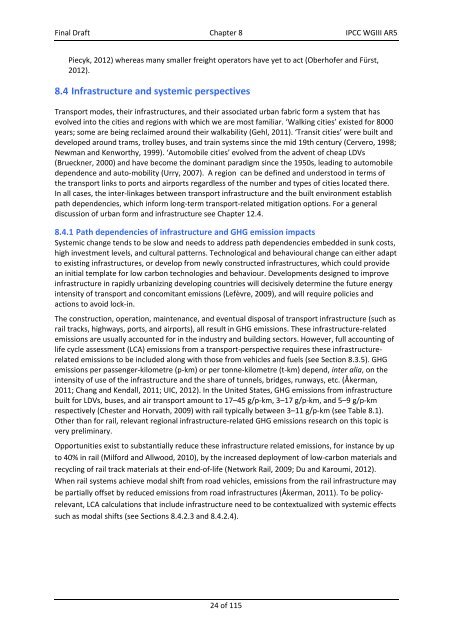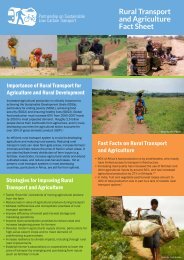ipcc_wg3_ar5_final-draft_postplenary_chapter8
ipcc_wg3_ar5_final-draft_postplenary_chapter8
ipcc_wg3_ar5_final-draft_postplenary_chapter8
Create successful ePaper yourself
Turn your PDF publications into a flip-book with our unique Google optimized e-Paper software.
Final Draft Chapter 8 IPCC WGIII AR5<br />
Piecyk, 2012) whereas many smaller freight operators have yet to act (Oberhofer and Fürst,<br />
2012).<br />
8.4 Infrastructure and systemic perspectives<br />
Transport modes, their infrastructures, and their associated urban fabric form a system that has<br />
evolved into the cities and regions with which we are most familiar. ‘Walking cities’ existed for 8000<br />
years; some are being reclaimed around their walkability (Gehl, 2011). ‘Transit cities’ were built and<br />
developed around trams, trolley buses, and train systems since the mid 19th century (Cervero, 1998;<br />
Newman and Kenworthy, 1999). ‘Automobile cities’ evolved from the advent of cheap LDVs<br />
(Brueckner, 2000) and have become the dominant paradigm since the 1950s, leading to automobile<br />
dependence and auto‐mobility (Urry, 2007). A region can be defined and understood in terms of<br />
the transport links to ports and airports regardless of the number and types of cities located there.<br />
In all cases, the inter‐linkages between transport infrastructure and the built environment establish<br />
path dependencies, which inform long‐term transport‐related mitigation options. For a general<br />
discussion of urban form and infrastructure see Chapter 12.4.<br />
8.4.1 Path dependencies of infrastructure and GHG emission impacts<br />
Systemic change tends to be slow and needs to address path dependencies embedded in sunk costs,<br />
high investment levels, and cultural patterns. Technological and behavioural change can either adapt<br />
to existing infrastructures, or develop from newly constructed infrastructures, which could provide<br />
an initial template for low carbon technologies and behaviour. Developments designed to improve<br />
infrastructure in rapidly urbanizing developing countries will decisively determine the future energy<br />
intensity of transport and concomitant emissions (Lefèvre, 2009), and will require policies and<br />
actions to avoid lock‐in.<br />
The construction, operation, maintenance, and eventual disposal of transport infrastructure (such as<br />
rail tracks, highways, ports, and airports), all result in GHG emissions. These infrastructure‐related<br />
emissions are usually accounted for in the industry and building sectors. However, full accounting of<br />
life cycle assessment (LCA) emissions from a transport‐perspective requires these infrastructurerelated<br />
emissions to be included along with those from vehicles and fuels (see Section 8.3.5). GHG<br />
emissions per passenger‐kilometre (p‐km) or per tonne‐kilometre (t‐km) depend, inter alia, on the<br />
intensity of use of the infrastructure and the share of tunnels, bridges, runways, etc. (Åkerman,<br />
2011; Chang and Kendall, 2011; UIC, 2012). In the United States, GHG emissions from infrastructure<br />
built for LDVs, buses, and air transport amount to 17–45 g/p‐km, 3–17 g/p‐km, and 5–9 g/p‐km<br />
respectively (Chester and Horvath, 2009) with rail typically between 3–11 g/p‐km (see Table 8.1).<br />
Other than for rail, relevant regional infrastructure‐related GHG emissions research on this topic is<br />
very preliminary.<br />
Opportunities exist to substantially reduce these infrastructure related emissions, for instance by up<br />
to 40% in rail (Milford and Allwood, 2010), by the increased deployment of low‐carbon materials and<br />
recycling of rail track materials at their end‐of‐life (Network Rail, 2009; Du and Karoumi, 2012).<br />
When rail systems achieve modal shift from road vehicles, emissions from the rail infrastructure may<br />
be partially offset by reduced emissions from road infrastructures (Åkerman, 2011). To be policyrelevant,<br />
LCA calculations that include infrastructure need to be contextualized with systemic effects<br />
such as modal shifts (see Sections 8.4.2.3 and 8.4.2.4).<br />
24 of 115



